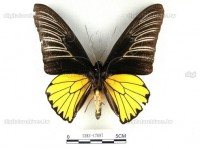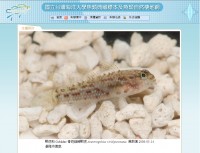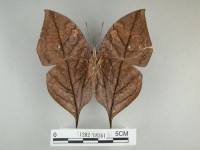|
Endemic Insects in Pongso No Tao (Lan Yu) |

Magellan birdwing butterfly (Troides magellanus(C. & R. Felder)) is one of the largest butterflies in Taiwan, the Kingdom of Butterflies. Wingspan of a female Magellan birdwing butterfly is as long as 15 center meters and as wide as 10 center meters. This species is found only in Lanyu (Orchid Island) of Taiwan. Its fore wings are black while the hind wings are golden. Hind wings of a male reveal red, green, and blue iridescence when viewed from certain angles. Magellan birdwing butterfly goes through complete metamorphosis. Its larva is colorful and feeds on Zollinger Dutchmanspipe. Its pupa is pupa adhaerena which hangs from a branch. Magellan birdwing butterfly is most active from March to April and from September to October. Its major nectar plant is Odollam Erberus tree. Comparing with other butterfly species, it flies relatively slow with a speed of four to five kilometers an hour. Due to depopulation of Zollinger Dutchmanspipe caused by farm land reclamation and over-collecting for its beautiful wings, the number of Magellan birdwing butterfly is in steep decline.
|
|
Read more...
|
|
Find Something New--Adventures in Fish Specimen Collection |
|
 Fishes, fishes swimming in the sea,” so goes the familiar tune that we’ve hummed countless times through our childhoods. Children eventually grow up, but this simple rhyme is sure to resonate in their minds whenever they walk down a riverbank or swim in the blue seas. But do they really know the multitudes of fish that live in our rivers and oceans? Can they identify fishes by name? What do they know about their behavior? Aiming to improve knowledge among the general public of fishes and their habitats, National Taiwan Ocean University has devoted much effort to building an internet database of fish specimens and natural habitats. They hope to aggregate all available information about fish from Taiwan and southeast Asia.
Fishes, fishes swimming in the sea,” so goes the familiar tune that we’ve hummed countless times through our childhoods. Children eventually grow up, but this simple rhyme is sure to resonate in their minds whenever they walk down a riverbank or swim in the blue seas. But do they really know the multitudes of fish that live in our rivers and oceans? Can they identify fishes by name? What do they know about their behavior? Aiming to improve knowledge among the general public of fishes and their habitats, National Taiwan Ocean University has devoted much effort to building an internet database of fish specimens and natural habitats. They hope to aggregate all available information about fish from Taiwan and southeast Asia.
|
|
Read more...
|
|
Butterflies of Formosa - Details |
|
 Mimesis is when some butterflies use their colors and shape to blend into the background, thus deceiving predators.
Mimesis is when some butterflies use their colors and shape to blend into the background, thus deceiving predators.
The Dead Leaf Butterfly, Kallima inachus, is a classic example. When wings are folded, the butterfly looks like a dried leaf with dark veins, mold specks, and cavities. Wing patterns on ventral sides of the Dead Leaf Butterfly vary considerably with individual.
|
|
Read more...
|
|
Butterflies of Formosa - Butterfly and Culture |
|
 Butterfly patterns are symbols of nobility commonly seen in northern Paiwan and Rukai tribal woodcarvings, furnishings, and totems. Butterfly patterns are symbols of nobility commonly seen in northern Paiwan and Rukai tribal woodcarvings, furnishings, and totems.
In Wutai Rukai tribal traditions, men that move and run rest can win the title of ‘lyalivarane’ (meaning butterfly). The chief will grant these men the right to wear a butterfly headdress. ......
|
|
Read more...
|
|
Butterflies of Formosa - Butterfly Conservation |
|
 The United Nations declared 2010 as the International Year of Biodiversity. This is to promote the philosophy that ‘biodiversity’ is life, ‘biodiversity is our life’, and humans and all life on Earth share the same future. The United Nations declared 2010 as the International Year of Biodiversity. This is to promote the philosophy that ‘biodiversity’ is life, ‘biodiversity is our life’, and humans and all life on Earth share the same future.
Biodiversity is decreasing rapidly due to human activities, such as destruction of natural habitats, environmental pollution, introduction or intrusion of alien species, and over-hunting.
|
|
Read more...
|
|
|
Butterflies of Formosa - Butterfly Industry |
|
1900’s – 1920’s / Initial Stage—Under Japanese Rule
1904 / Kiyomatsu Asakura started collecting and trading insect specimens in Puli.
1906 / Kiyomatsu Asakura established Asakura Kabushiki Kaisha and hired many local Taiwanese (including Mokuse Yu) to collect butterflies for him. Some specimens were sold to Japanese entomologists (e.g. Shonen Matsumura) for research. ......
|
|
Read more...
|
|
|
<< Start < Prev 1 2 3 4 5 6 7 8 9 10 Next > End >>
|
|
Page 3 of 11 |